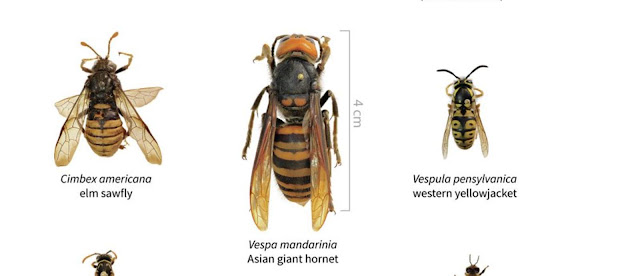There’s a new invasive species on American soil, and it’s particularly terrifying. The first reports that Asian giant hornets, a species that entomologists simply call “murder hornets,” were filed last fall in Washington state. In the intervening months, researchers have worked to eradicate the hornets’ burgeoning populations, according to the New York Times.
Invasive species in general can wreak havoc on ecosystems. A lack of natural predators allows many to overrun local flora and fauna, sometimes driving them to extinction. But the Asian giant hornet, native to the warmer climates of Asia, is really bad news in the US. “If it becomes established, this hornet will have negative impacts on the environment, economy, and public health of Washington State,” according to the state’s agriculture department. Here are the qualities of the murder hornet north america that make it a force to be reckoned with.
It can kill people
Despite their moniker, murder hornets aren’t naturally interested in killing people. That only happens when they have to defend themselves, like if a person threatens to step on its nest, which it makes, rather alarmingly, in the ground. If you happen to be the unlucky sap on the receiving end of a murder hornet attack, here’s what you’re likely to get: The insects flying at you at up to 25 miles per hour and the potential for multiple stings from the same hornet. Those stings can be excruciating—one oft-stung entomologist told the New York Times that a sting from the Asian giant hornet was the most painful he’d ever experienced.In fact, the venom that comes with the sting can send a human recipient into anaphylactic shock or organ failure, breaking down flesh and fraying nerve endings. The hornets typically kill about 50 people per year in Japan. In one particularly lethal spate in 2013, 42 Chinese people died and more than 1,600 were injured from the hornets’ stings. Those who survive can have physical effects that last for months, including inflammation of the heart and liver.
It decimates bee populations
The hornet’s effect on humans seems fairly minimal once you learn what they do to bee populations. When the hornets discover a honey bee hive, they invade it and use their large jaws to decapitate the residents at terrifying speed (they can kill 30,000 bees within a few hours), eventually taking the hive as their own.In Asia, where the hornet is native, local honey bee populations have developed a way to defend themselves: They surround a hornet and vibrate, raising the temperature and cooking the invader to death. Unfortunately, honey bees in North America have no such defenses. If the murder hornet becomes established here, it could be the death knell for the already imperiled honey bees.
It’s hard to kill
In China, locals attack the hornets’ nests with sacks, fire, water, smoke, poison, or fire extinguishers, along with some more sophisticated technologies like a jerry-rigged welding gun. (In Japan, venomous hornets are also used to create liquor—a defense that humans in North America, like the honey bees, have not yet developed.)In the US, researchers and beekeepers are experimenting with homemade hornet traps, though if the hornet queen is still alive, a population will continue.
So what should you do if you think you see one? First be sure, then report it, then stay the heck away. “Don’t try to take them out yourself if you see them,” Chris Looney, an entomologist with Washington’s agriculture department, told Washington State University last month. “If you get into them, run away, then call us! It is really important for us to know of every sighting, if we’re going to have any hope of eradication.”


EmoticonEmoticon